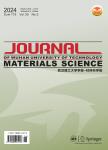The Drug-carrier Interactions, Release Behaviors and Cell Responses of Hydroxyapaptite Containing Several Chinese Medicines
The Drug-carrier Interactions, Release Behaviors and Cell Responses of Hydroxyapaptite Containing Several Chinese Medicines作者机构:Key Lab of Advanced Technologies of Materials Ministry of Education School of Materials Science and Engineering Southwest Jiaotong University
出 版 物:《Journal of Wuhan University of Technology(Materials Science)》 (武汉理工大学学报(材料科学英文版))
年 卷 期:2013年第28卷第1期
页 面:163-171页
核心收录:
学科分类:1007[医学-药学(可授医学、理学学位)] 10[医学]
基 金:Funded by National Basic Research Program of China (973 Program) (No.2012CB933602) National Natural Science Foundation of China (No.50975239) the Key Project of Chinese Ministry of Education (No.109137) the Fundamental Research Funds for the Central Universities (Nos.SWJTU11CX118 and SWJTU11ZT05)
主 题:hydroxyapatite chinese medicines crystallinity crystal size drug release cell response
摘 要:The present work shows drug-carrier interactions, release behaviors and cell responses of hydroxyapatite (HA) containing salvianolic acid B (Sal B), astragalus polysaecharide (APS), and naringin. X-ray diffraction (XRD) showed that the crystallinity and crystal size of HA decreased significantly when Sal B was added (p〈0.05). Transmission electron microscope (TEM) confirmed that the nano-acicular crystals of HA containing Sal B were the most fine among all specimens. It was conjectured that Sal B preferentially adsorbed on the positively charged surface of HA crystals to inhibit their growth. In vitro release of HA containing Chinese medicines followed the first-order equation. The drug-carrier affinity between HA and Sal B might have prolonged the release of Sal B. The proliferation and differentiation of osteoblasts were promoted by Chinese medicines containing HA in the time and dosage dependent manner. The osteoblasts displayed a polygonal morphology with cell-cell junctions in all cases. It is suggested that the contained Chinese medicines would promote the activities of the osteoblasts.



